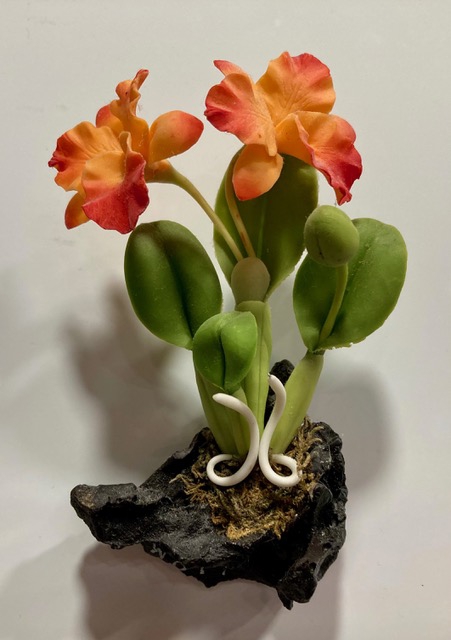
Blogs
Tree Analogy #5-Bloom
Thursday, October 24, 2024 by Phyllis Smith Kester
 I have a magnet from Hawaii that shows flowers growing out of black volcanic rock. It occupies the corner of my refrigerator door because it reminds me of trees (and other plants) growing out of hardened lava or other seemingly impossible environments. Over the years, I’ve taken many pictures of trees struggling to live in bad settings because I’ve found them inspiring. The tree has no choice about its circumstances, yet it attempts to grow wherever it ends up. I’ve often looked at my little magnet and thought, “Bloom where you are Planted.” Then, I would picture trees growing in difficult rocky places.
I have a magnet from Hawaii that shows flowers growing out of black volcanic rock. It occupies the corner of my refrigerator door because it reminds me of trees (and other plants) growing out of hardened lava or other seemingly impossible environments. Over the years, I’ve taken many pictures of trees struggling to live in bad settings because I’ve found them inspiring. The tree has no choice about its circumstances, yet it attempts to grow wherever it ends up. I’ve often looked at my little magnet and thought, “Bloom where you are Planted.” Then, I would picture trees growing in difficult rocky places.
However, my mental tree picture shifted after Monty and I took a long jeep ride west of the Dead Sea in Israel. Our driver had located a Bedouin couple hired to care for pregnant camels. Their job was to care for about half a dozen camels as they birthed their babies and to care for the young camels as long as the owner wanted. We set out to find the Bedouin couple. It involved a long drive into the Judean Desert over terrain with only trails, not real roads. We followed dry river beds and sometimes dirt trails others had taken.
Eventually, we found the young Bedouin mother with her three young boys. Everything for her family and the camels, including water and food, had to be brought in by a vehicle, camel, or donkey while they cared for about half a dozen momma camels with their just-born babies. It bothered me that the nearest people were miles away—before cell phones—and she didn’t look like she had any type of communication. It was almost like in the days of Abraham, except she had a vehicle.
Although intrigued with the baby camels, I was more astounded by the young human family and their choice of how and where to live. The beautiful young mother was cheerful as could be, although I didn’t speak her language. Her husband was not there, and I was told he was off getting supplies. I looked at the rock circle where she cooked and the pickup next to their tent home and marveled at the patience and tenacity necessary to bring everything needed by truck or donkey. Then I wondered how I would have responded if I were in her shoes. I felt very spoiled to have lived with electricity, a phone, a stove, and an automatic clothes washer when my sons were in diapers.
As we drove back, I noticed a small, lonely tree growing on the bare, dirt and rock-exposed area. I quickly snapped a picture as we passed for it was the only tree I remembered seeing on that cold January day. Since the tree was green, I assumed it was an evergreen. What a bewildering place for an evergreen tree.
After we got home and I examined my pictures, I wondered what type of tree could grow in the Judean Desert. I remembered the tamarisk tree Abraham planted in Beersheba (Genesis 21:33), a similar area not far from the tree I saw. With research, I discovered tamarisk trees are evergreen, tolerant of drought, and ideal for arid climates since they withstand heat and long dry spells by sending roots deep down to find underground water. Since tamarisks are very slow-growing, Abraham didn’t plant one for his enjoyment. It symbolized hope and faith or the expectation of God’s blessing on descendants because that tree is planted for future generations.
This isolated tree planted in a hostile place reminded me of four young men (probably teenagers) taken as captives by Nebuchadnezzar to a pagan Babylon. They were also “planted” in a hostile place.
Daniel and his friends were, among other Jewish boys, taken captive to be in the pagan king's court. They would remain in a pagan land with pagan customs for the remainder of their days—the entire 70-year captivity. They were “brainwashed” because they were given new names and forced to learn the language, customs, and teachings of this new pagan culture. They were also probably stripped of their manhood because it would have been the custom to make them eunuchs. We know nothing about the other captives because these four stand out. They rose in prominence because God blessed their efforts since they didn’t compromise and did their best as unto the Lord.
When Daniel arrived (or was “planted”) in Babylon, he couldn’t change many of his circumstances, but he had control over his character. He could respond to his heathen conqueror with resentment and hostility, or respect and humility. I marvel that he demonstrated poise, deference, and even compassion for his Babylonian captors for over seventy years.
How did Daniel serve an evil king without compromising his character? When he found it necessary to oppose the king’s orders, he did so with great diplomacy and trusted God with the outcome.
Imagine him spending his entire adult life as a stranger in a foreign land, without a wife or children. Yet he walked with God every day of his life and exercised such discipline and strength of character that he became one of the most influential people in the world's most powerful kingdom.
Despite his circumstances, Daniel lived and thrived through four different kingdoms—even serving as a government official to four kings: Nebuchadnezzar (after Daniel interprets his dream, Daniel 2:48), Belshazzar (after Daniel reads the original handwriting on the wall, Daniel 5:29), Darius the Mede (Daniel 6:1-3, 11:1), and Cyrus of Persian (Daniel 6:28, 10:1).
And toward the end of his life (probably in his eighties), Daniel continued to pray to God and not the king, even though it put him in danger of being eaten by lions. Have you noticed the Bible gives us no dirt on Daniel? When his jealous political opponents tried to get dirt on him, their only option was to make it illegal to obey God. (Daniel 6:4-5).
Daniel and his life remind me of that solitary tree in the dry Judean desert. Yes, I want to bloom wherever I happen to be planted, but I also want to be like Daniel and stand firmly planted in God’s word regardless of the pagan culture in which I find myself. Have you considered that since Daniel influenced his pagan culture and was a top official over the wise men (Da 2:48; 4:9, 5:11), he probably influenced the Magi, or wise men, who later came looking for the birth of Messiah when Jesus was born many years later. We know they were wise men from "the East," most likely Persia or modern-day Iran. They most likely knew of the teachings and writings of Daniel, who in the past had been the chief of the court seers in Persia when he was in captivity.
God seems to delight in taking people in difficult circumstances and using them in surprising ways to further His kingdom. Picture that solitary tree in the desert as you ponder this.
So yes, let us grow and bloom wherever we are “planted”—just as that solitary tamarisk tree was doing in the Judean Desert. Let us resolve to be all we can be and do everything to God's glory regardless of our circumstances. Let us live a culturally engaged life based on biblical principles because when we are not involved, we open the door to evil agendas and ideologies. This means we vote and participate in whatever ways we can as law-abiding citizens so that our lives may bring glory to God. Let us be—like Daniel—the best we can be because we don’t know what influences our one life, one vote, and one voice may have in God’s plan.
“Abraham planted a tamarisk tree in Beersheba, and there he called on the name of the LORD, the Eternal God.” Genesis 21:33 NIV
Comments
Linda Evans From Lynchburg, Va At 10/29/2024 3:35:34 PM
Reminder to always stand strong in God!Reply by: Phyllis
Thanks for stopping by, Linda.Previous Posts
Dreaming
Phyllis Smith Kester
5/21/2025
Tornado Alley
Phyllis Smith Kester
5/5/2025
Geodes--Part 2
Phyllis Smith Kester
4/23/2025
1940s in Oklahoma
Phyllis Smith Kester
4/8/2025
Buel Overcomes Adversity
Phyllis Smith Kester
3/24/2025
Buel Smith & Pitchers
Phyllis Smith Kester
3/11/2025
Remembering Grandpa Smith
Phyllis Smith Kester
2/26/2025
Meeting Corrie ten Boon
Phyllis Smith Kester
2/10/2025
Walking the Plank
Phyllis Smith Kester
1/28/2025
Train Ride in a Flood
Phyllis Smith Kester
1/13/2025
Saltillo Surprises
Phyllis Smith Kester
1/1/2025
Connecting Two Pictures
Phyllis Smith Kester
12/18/2024
Kintsugi Brokenness & Beauty
Phyllis Smith Kester
12/3/2024
Capillary Action
Phyllis Smith Kester
11/20/2024
A Forge and Anvil
Phyllis Smith Kester
11/5/2024
Tree Analogy #5-Bloom
Phyllis Smith Kester
10/24/2024
Tree Analogy #4: Brokenness
Phyllis Smith Kester
10/9/2024
Israel and Golan Heights
Phyllis Smith Kester
9/25/2024
Tree Analogy #3: Bent Tree
Phyllis Smith Kester
9/11/2024
Lesson From NASA
Phyllis Smith Kester
8/27/2024
Storm Warning
Phyllis Smith Kester
8/14/2024
Tree Analogy #2: Hanging Sod
Phyllis Smith Kester
7/31/2024
Tree Analogy #1: Angel Oak
Phyllis Smith Kester
7/17/2024
The Warning Shot
Phyllis Smith Kester
7/2/2024
Trip's Delayed Surprise
Phyllis Smith Kester
6/18/2024
Antelope Slot Canyon
Phyllis Smith Kester
6/4/2024
The Pioneer Woman
Phyllis Smith Kester
5/21/2024
What is a Woman, a Wife, or a Mother?
Phyllis Smith Kester
5/8/2024
Two Analogies
Phyllis Smith Kester
4/24/2024
Solar Eclipse Analogy
Phyllis Smith Kester
4/10/2024
EASTER
Phyllis Kester
3/26/2024
The Resurrection Plant
Phyllis Smith Kester
3/12/2024
Busted on Pikes Peak
Phyllis Smith Kester
2/27/2024
What is Love?
Phyllis Smith Kester
2/13/2024
Looking, But Not Seeing
Phyllis Kester
1/30/2024
Remembering Christmas 2023
Phyllis Kester
1/16/2024
The Potter
Phyllis Kester
1/2/2024
The Tree Ornament
Phyllis Kester
12/19/2023
Cockapoo Kristy
Phyllis Kester
12/6/2023
Surprises & Obsessions
Phyllis Kester
11/21/2023
Breaking Thru
Phyllis Kester
11/7/2023
Eagles
Phyllis Kester
10/24/2023
Facing Fear
Phyllis Kester
10/10/2023
The Bug-Eyed Monster
Phyllis Kester
9/25/2023
The Flash Flood
Phyllis Kester
9/12/2023
David's Library Book
Phyllis Kester
8/29/2023
Object Lesson: The Leaky Bucket
Phyllis Kester
8/16/2023
Turpentine Creek
Phyllis Kester
8/1/2023
The Surprise
Phyllis Kester
7/17/2023
Small Pleasures
Phyllis Kester
7/4/2023
Are Fathers Important?
Phyllis Kester
6/20/2023
Fathers and Father's Day
Phyllis Smith Kester
6/6/2023
Legacies of my mother, Hallie Hays Smith
Phyllis Smith Kester
5/23/2023
Hallie's Handkerchief Holder
Phyllis Kester
5/9/2023
A Voice from the Past
Phyllis Kester
4/25/2023
Object Lesson: The Crystal Paperweight
Phyllis Kester
4/11/2023
Grandma’s Quilting Bee
Phyllis Kester
3/28/2023
Actions have Consequences
Phyllis Kester
3/14/2023
Hungry Baby
Phyllis Kester
2/28/2023
Married to a Texan
Phyllis Kester
2/14/2023
Charley Kester’s Horses
Phyllis Kester
1/31/2023
Persistence In The Dirt
Phyllis Kester
1/17/2023
Object Lesson: Mushrooms in Our Life
Phyllis Kester
1/3/2023
Trip with Unexpected Twists
Phyllis Kester
12/20/2022
Grandma’s Important Legacy
Phyllis Kester
12/6/2022

